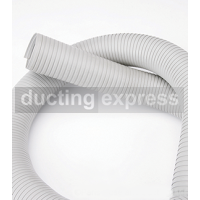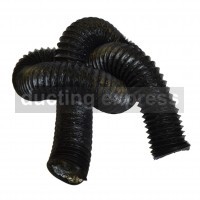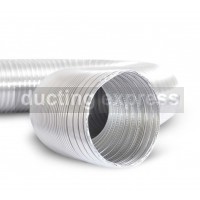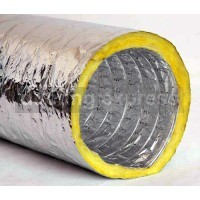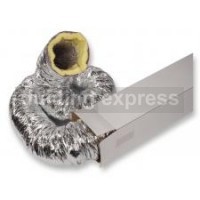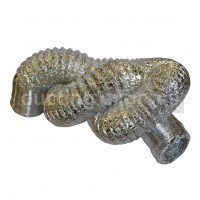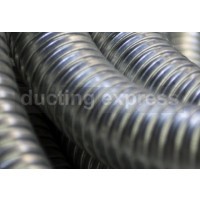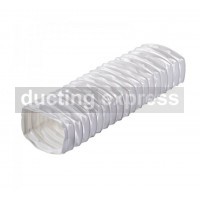Flexible Ducting
Flexible ducting or flex is often suited when space is restricted or in an awkward position. It is commonly used in circumstances where rigid ducting isn’t possible for use with an installation.
When using flexible ducting in a system you should ensure that the duct is pulled taught so that the full internal diameter is obtained and resistance is minimised. You should also keep bends and kinks to a minimum as they can affect airflow and efficiency of a ventilation system.
Flexible duct is available in various different materials, each with different properties to suit your needs.
Types of flexible ducting:
Polyurethane (PU) flexible ducting - This is often used for the suction & transportation of dust, chips & abrasive materials. It is made of polyurethane with a galvanised steel spiral which gives it a high degree of flexibility. PU flex can also be anti-static and food grade; anti-static PU flex is most commonly used for gases, abrasive dust, powder & fibres, oil & spray mist extraction & any application where there is a risk of electrostatic charge build up. Food grade flexible ducting is made of an odourless & tasteless food-grade polyurethane. This material is also microbe & hydrolysis-resistant.
Aluminium flexible ducting - This un-insulated flex is a reinforced aluminium and polyester laminated ducting with a high tensile steel wire helix. It is fully flexible, can be easily cut to size. It is generally used for ventilation where the duct doesn’t travel through cold areas or areas where there is a temperature change so there is no chance of condensation forming inside the duct.
Aluminium insulated flexible ducting - This ducting is designed to prevent condensation and minimise heat loss and we recommend to use this in applications where it passes through unheated/cold space. This insulated ducting is constructed with an inner duct with fibreglass insulation covered with an outer jacket which acts as a vapour barrier.
Acoustic flexible ducting - Similar to the aluminium insulated flexible ducting, it is an inner duct with fibreglass insulation. However, with acoustic aluminium flexible ducting the inner core is perforated to allow for sound attenuation. This kind of ducting is designed to reduce noise in ducted systems.
Rectangular flexible ducting - This is a pvc flexible ducting which is often used in ventilation systems where space is restricted and circular ducting cannot be used. Rectangular flexible ducting is available in two sizes, 110x54mm & 204x60mm, to fit standard rigid rectangular duct sizes.
Semi flex - Semi-flexible ducting is designed for flexible connections between ventilation system components. No toxic vapours are released should a fire occur as the ducting does not contain PVC. Semi flex can work at a temperature range of up to 250°C.
Combi flex - This ducting is constructed of a combination of laminated, reinforced Aluminium/Polyester & PVC. The layers of these materials together in one product allows extra strength, durability and stability. The combination flexible ducting has a seamless smooth interior surface when fully extended which ensures a low-pressure drop and doesn’t allow dust to collect in crevices.
High temperature silicone flexible hose - This double layer flexible silicone hose is suited for use with hose and cold gases and has a large temperature range of -70°C to 260°C.
Metal flexible ducting - This galvanised steel ducting has a high tensile strength & strong resistance to crushing. It is well suited to absorbing vibration, thermal expansion & noise attenuation, ducting of smoke & fumes & dry bulk handling. Its other main benefit is its heat-resistance which enables it to operate at temperatures of up to 500°C.
Vacuum hose - This PVC vacuum hose is well suited as a replacement hose for use with domestic and industrial vacuum cleaners.
Car exhaust extraction flexible ducting - This type of ducting can be used to remove vehicle exhaust gases. It is crush resistant which allows it to be roll-over proof. Exhaust hose can withstand a high range in temperatures with highs up to 200°C. Wyrem flex - This flexible ducting is highly resistant to abrasion. It is made of double-reinforced layers of Chloroprene-coated cotton & 2 spring steel helices.
Flexible Tubing
There are many advantages of using flexible ducting, the advantages of using flexible tubing are: Installation - When compared with rigid ducting, flexible ducting is faster and easier to install. To install flexible ductwork you should first fully extend the ducting and then cut to exact length required to minimise airflow resistance. To do this you shouldn’t need any special tools, just a sharp knife or pliers/wire cutters. To fix to a fan spigot or fittings you can simply use jubilee clips (hose clips) or duct tape.
Price - Flexible tubing is relatively cheap but in some circumstances, for example in wood working systems, flexible ducting should be treated as a consumable and will need to be replaced on a regular basis.
Flexibility - Due to the ducting being flexible, flexible tubing can be used in tight spaces, around sharp bends or around obstructions where it wouldn’t be possible to use rigid ductwork.
If you have a welding fume extraction filter, occasionally you may be required to replace your flexible dust extraction hose. Ducting Express can supply the replacement PVC coated ducting in various different lengths of flexible tubing to suit your flexible extraction arm.
If you require further information, price and availability of flexible ducting, do not hesitate to contact our team today.
-

PU Flexible Ducting (6 Meter Lengths) Anti Static Light Duty
-

Anti Static PU Flexible Ducting (10 Meter Lengths)
-

Food Grade PU Flexible Ducting (10 Meter Lengths)
-

Anti-Static Black Polyurethane Flexible Ducting (10 Meter Lengths)
-

PVC Coated Glass Flexible Ducting (6 Meter Lengths)
-

High Temperature Silicone Flexible Hose
-

High Temperature Metal Flexible Ducting
-

Car Exhaust Extraction Flexible Ducting
-

StayPut Flexible Ducting
-

Flexible Welding Arm Flex
-

Combi Flex
-

Semi Flex
-

Acoustic Flex
-

Aluminium Insulated Flex
-

Aluminium Uninsulated Flex
-

Metal Flexible Ducting
-

Rectangular PVC Flexible Ducting
-

Vacuum Hose



